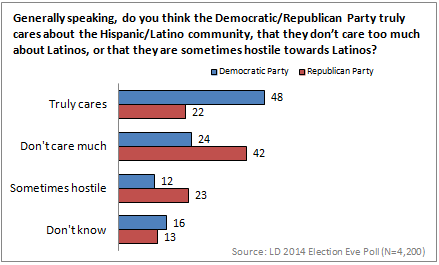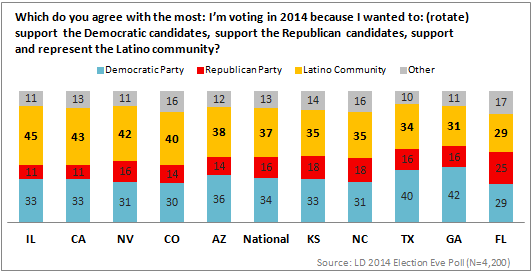In the aftermath of the 2012 election, political observers and pundits of all political stripes contended that the support of Latino voters was pivotal to President Obama’s victory over Mitt Romney. Indeed, the 2012 ImpreMedia/Latino Decisions Election Eve poll reported that Obama received the support of 75% of Latino voters as compared to 23% for Romney and Latino voters were deterministic in Obama’s victories in Colorado, Florida, New Mexico, and Nevada and were critical to the President’s ability to carry Ohio and Virginia; states that collectively account for roughly 30% of the Electoral College votes needed to win the presidency.
The response from the Republican establishment was immediate. During an appearance on NBC’s Meet the Press in June 2013, Senator Lindsey Graham (R-SC) declared that the Republican Party is “in a demographic death spiral as a party and the only way we can get back in good graces with the Hispanic community in my view is pass comprehensive immigration reform. If you don’t do that, it really doesn’t matter who we run [in 2016] in my view.”
Graham’s comment followed the Republican National Committee’s (RNC) “Growth and Opportunity Project,” which noted that, “if Hispanics think that we do not want them here, they will close their ears to our policies. In essence, Hispanic voters tell us our Party’s position on immigration has become a litmus test, measuring whether we are meeting them with a welcome mat or a closed door.”
Soon thereafter the GOP began to constructively engage on the most pressing policy priority of the Latino electorate: immigration reform. In June of 2013 the U.S. Senate–with the support of 14 Republicans–passed comprehensive immigration reform (S.744) that included a pathway to citizenship for unauthorized immigrants. However, any impetus for the Republican Party to deliver on immigration reform eroded once the focus shifted to the Republican controlled House of Representatives.
In the minds of many House Republicans acting on immigration reform is tantamount to political suicide as any legislation including a pathway to citizenship would create more Democratic voters and expedite changes to the country’s political demography undercutting the party’s electoral prospects. Moreover, with few Republican representing districts with significant shares of Latino voters, there are limited contexts where Republicans can be punished electorally for inaction on immigration reform. Instead, movement on immigration reform might engender a primary challenge where Republican incumbents would be forced to compete in a low-turnout, intra-party election composed of more ideological voters.
In the face of House Republicans’ recalcitrance, the Obama administration began signaling that it would use executive authority to stem the tide of deportations. Yet, in response to concerns that executive action coming so close to the 2014 elections would harm the reelection bids of some Democratic Senators, President Obama opted to delay such action until after the 2014 election.
For both the Democrats and the Republicans, short-term political considerations trumped the policy preferences of the Latino community and provided grist to America’s Voice founder Frank Sharry’s observation that “It’s never convenient to help out Latinos.”
While the political calculations underlying both parties’ decisions are easy to understand, what is less clear is the impact that these decisions had on Latino voters in 2014 and beyond. Below, I draw on the 2014 Latino Decisions Election Eve Poll to provide an overview of the linkages between immigration reform, voter participation, and partisan support. These data suggest four key takeaways.
1. Immigration remains a gateway issue. First, although political expedience may cause candidates of both parties to tread lightly on the immigration issue, for most Latino voters, immigration is a deterministic issue. Specifically, 67% of Latino voters responded in the Election Eve Poll that immigration was either the most important or one of the most important factors in shaping their vote choice.
2. Turnout and immigration are linked. Second, how the parties address the issue not only affects how Latinos vote, but also whether they vote at all. Among Latinos registered to vote but who did not turn out in 2014, 60% reported that the decision by President Obama to delay executive action on immigration made them less enthusiastic about the president and the Democratic Party.[i] Yet, an even larger share (68%) of these non-voting Latinos responded that they would be more enthusiastic about the Democratic Party in the future if President Obama were to enact an executive order limiting deportations as he did in late November.
3. Democratic support is fragile. Third, any lock that the Democrats might think they have on Latino voters is fragile. Not only were there declines in Latino support for Democratic House and Senate candidates in 2014 as compared to 2012, but our poll also suggests that the Democrats are viewed by many Latino as not being overly concerned with the Latino community.

As the illustration indicates more than twice as many respondents felt that the Democrats truly care about the Latino community as compared to the GOP. However, this attitude is shared by less than half of Latino voters.
4. Partisanship is not necessarily driving turnout. Fourth, Latino political participation is not necessarily tied to partisanship.

As the figure indicates, nationally, more Latinos indicated that they were voting to support the Latino community (37%) as opposed to supporting the Democratic Party (34%); a results that holds in all but two of the state specific samples. This represents a shift as compared to 2012 when 39% of Latino voters responded that they were voting to support the Democratic Party and 36% stated that their vote was motivated to support the Latino community.
In sum, participation in the electoral process for many Latinos requires responsiveness, inspiration, and mobilization. Yet, many Latinos feel ignored by the Democrats and under attack by the Republicans. As a consequence, while the Democrats continue to receive the benefit of the doubt among many Latino voters, the party did little to consolidate Latino support in 2014.
In subsequent posts, I will be assessing how the confluence of political, contextual, and geographic factors shaped the influence of Latino voters in elections to the U.S. Senate and in Republican and Democratic held Latino Influence districts in the House of Representatives.
[i] The 2014 Latino Decisions Election Eve Poll included a national sample of 200 registered Latino voters who did not vote in 2014.
David Damore is a Senior Analyst at Latino Decisions. He is Associate Professor of Political Science at the University of Nevada, Las Vegas, and a Senior Nonresident Fellow in the Brookings Institution’s Governance Studies Program.


